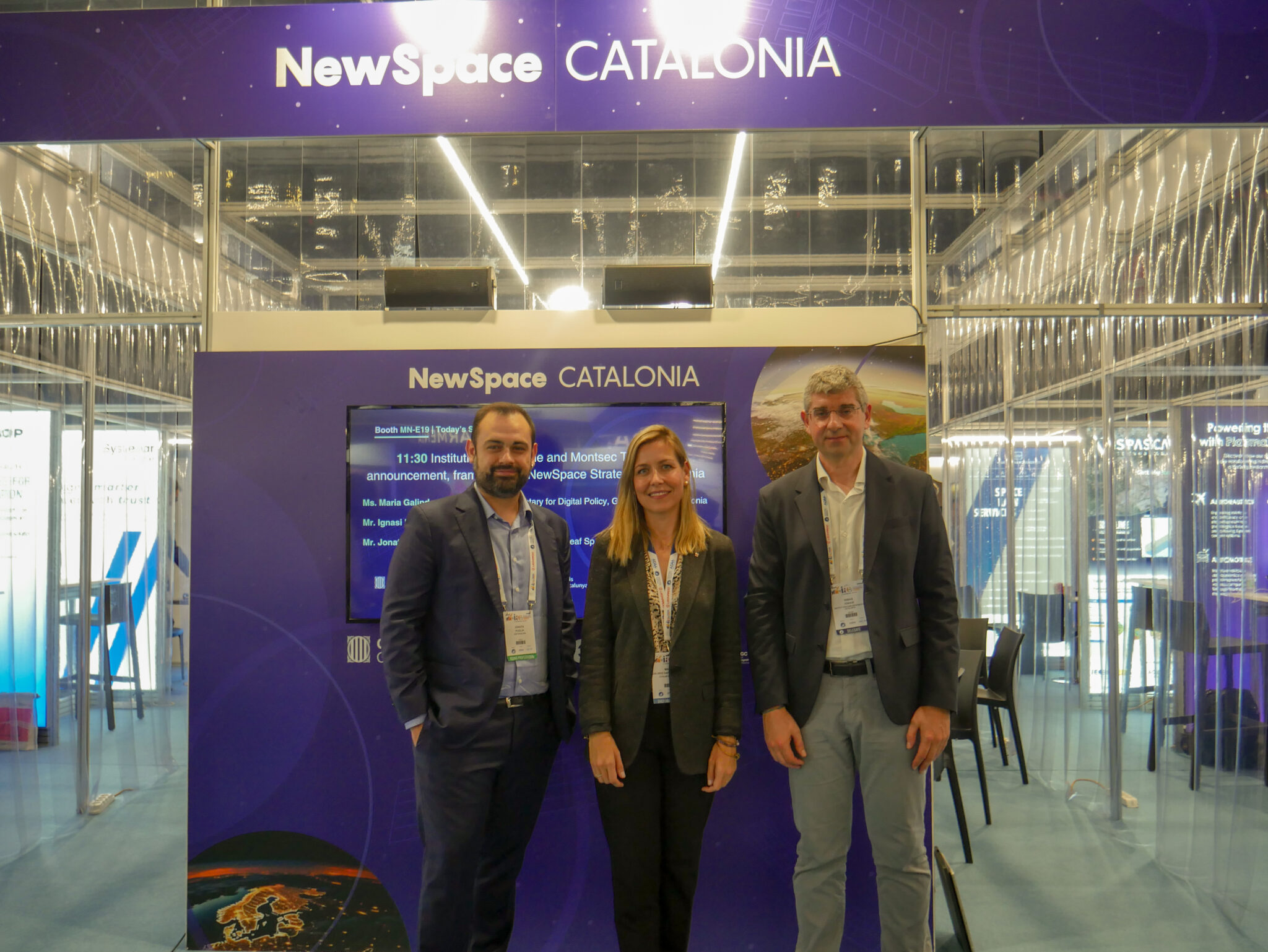Catalonia will launch the Sant Esteve Teleport at the Montsec Observatory in May 2025 as part of the Catalan Government’s NewSpace Strategy
- The secretary for Digital Policies, Maria Galindo, and the director of the IEEC, Ignasi Ribas, announced it today in Milan at an event in the Catalan pavilion of the IAC 2024 international space congress
- The Italian company with office in Catalonia Leaf Space, an international benchmark in satellite communications services, will install and operate a ground control station with the collaboration of the IEEC
- The Sant Esteve Teleport is a strategic infrastructure with industrial applications that will allow to provide service to the satellite market both on a Catalan and international scale

Caption: Jonata Puglia, co-founder and manager of Leaf Space, Maria Galindo, secretary of Digital Policies of the Government of Catalonia, and Ignasi Ribas, director of the IEEC.
Credits: IEEC.
The first satellite data control and reception ground station in Catalonia promoted by the Government of Catalonia in collaboration with the Institute of Space Studies of Catalonia (IEEC — Institut d’Estudis Espacials de Catalunya) will start its activity next May at the facilities of the Sant Esteve Teleport of the Montsec Observatory (OdM). This morning, the secretary of Digital Policies, Maria Galindo, and the director of the IEEC, Ignasi Ribas, announced it in an event at the ‘NewSpace Catalonia’ stand promoted by both entities at the International Astronautical Congress (IAC) 2024 in Milan. Jonata Puglia, co-founder and manager of Leaf Space, an international benchmark company in satellite communications services that will install and operate the ground station with the collaboration of the IEEC, participated in the announcement, which was made before the Catalan and international space ecosystem present at the congress.
This communications station will become a pioneering infrastructure in Catalonia, already fully equipped to offer service in the entire vertical structure of the satellite operation, which will allow companies from Catalonia and all over the world to control and receive data from satellite missions through local infrastructure.
In this sense, Maria Galindo said that “the Sant Esteve Teleport is a key infrastructure to empower the Catalan ecosystem of space and make it more competitive in the global market, as it will allow it to provide service both on a Catalan and international scale.” The secretary for Digital Policies recalled that “planting seeds to grow the ecosystem and developing key infrastructures, both for research and to accelerate the validation of technology, are two of the great objectives of the NewSpace Strategy that we at the Government promote in collaboration with the IEEC, the i2CAT Foundation and the Cartographic and Geological Institute of Catalonia.” As it is also, she added, “continuing to promote international collaboration in this global sector, promoting the participation of the Catalan ecosystem in world space debate forums such as IAC 2024, where we facilitate the participation of 17 companies.”
In the same vein, Ignasi Ribas has assured that “this first terrestrial station for control and reception of satellite data in Catalonia promoted by the Government of Catalonia in collaboration with the IEEC will promote that the Catalan space ecosystem continues to develop technological innovation projects through this new incorporation of capacities in the territory”. The director of the IEEC also wanted to highlight that “the satellite missions promoted by the NewSpace Strategy, such as Menut or the future GENEO-2 mission, will use the Sant Esteve Teleport station for mission control and data download”.
Leaf Space, an Italian company with an office in Catalonia that offers satellite connectivity services on an international scale, will integrate the Sant Esteve Teleport station into its worldwide network, which provides satellite service in all types of orbits. The telecommunications station, with a disc diameter of approximately 4 metres, will be of tri-band type, that is, it will offer data uploading and downloading capabilities on the S-band, and downloading on the X and Ka bands of the radio spectrum.
In this sense, Jonata Puglia highlighted the importance of the Catalan ecosystem for Leaf Space “as a space to grow as a company” and the suitability of Montsec “as a location to develop new important infrastructures for the services provided by the company worldwide.”
The Montsec Observatory, managed by the IEEC, is located in a unique area in Catalonia in terms of the lack of radio noise and dark sky conditions. With this first ground station for the control and reception of satellite data, the OdM’s potential as an ideal location for both astronomical observation, satellite telecommunications and optical communications is expanded.
Contacts
IEEC Communication Office
Castelldefels, Barcelona
E-mail: comunicacio@ieec.cat
About the IEEC
The Institute of Space Studies of Catalonia (IEEC — Institut d’Estudis Espacials de Catalunya) promotes and coordinates space research and technology development in Catalonia for the benefit of society. IEEC fosters collaborations both locally and worldwide and is an efficient agent of knowledge, innovation and technology transfer. As a result of more than 25 years of high-quality research, done in collaboration with major international organisations, IEEC ranks among the best international research centres, focusing on areas such as: astrophysics, cosmology, planetary science, and Earth Observation. IEEC’s engineering division develops instrumentation for ground- and space-based projects, and has extensive experience in working with private or public organisations from the aerospace and other innovation sectors.
The IEEC is a non-profit public sector foundation that was established in February 1996. It has a Board of Trustees composed of the Generalitat de Catalunya, Universitat de Barcelona (UB), Universitat Autònoma de Barcelona (UAB), Universitat Politècnica de Catalunya · BarcelonaTech (UPC), and the Spanish Research Council (CSIC). The IEEC is also a CERCA centre.
